Exploring Continents | Chapter 7 | Geography | 8th Social Science - Australia | 8th Social Science : Geography : Chapter 7 : Exploring Continents: Africa, Australia and Antarctica
Chapter: 8th Social Science : Geography : Chapter 7 : Exploring Continents: Africa, Australia and Antarctica
Australia
Australia
Australia was the last of all the
continents to be discovered, and this was due to its remoteness.
Australia is the largest island and
smallest continent in the world. It is the only continent that completely
occupies a single country. It has diverse in unique flora and fauna. Now let us
explore the continent.
Australia was discovered
by Captain James Cook, an English Seaman in 1770.
Location and Size:
Australia extends from 10°4' south to 39º 08' south latitudes and 113º 09' east to 153º39' east longitudes. The Tropic of Capricorn cuts the continent almost into two equal halves. Area of the country is about 7.68 million sq km.
Political Divisions
There are six states and two Union
Territory in Australia 1) New South Wales 2) Queensland 3) South Australia 4)
Tasmania 5) Victoria 6)Western Australia 7) Northern Territory 8) Capital
Territory (Canberra). Each state has its own state constitution. Canberra is
the capital ofAustralia. Sydney, Brisbane, Adelaide, Hobart, Melbourne, Perth
and Darwin are the other important cities of Australia.
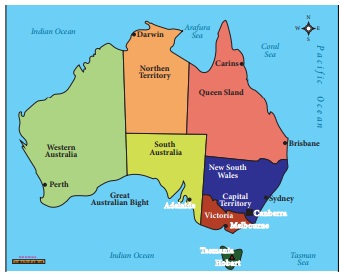
Australia has 8,222 islands. Rottnest Island, Magnetic Island, Fitzroy Island, Fraser Island, Phillip Island, Lord Howe Island, Kangaroo Island and Whitsunday Islands are the major islands.
Physical Divisions
It is the continent with very low irregularities in topography. Based on the nature of topography, it can be divided into three physical divisions namely:
1.
The Great Western Plateau
2.
The Central Low lands
3. The Eastern High lands
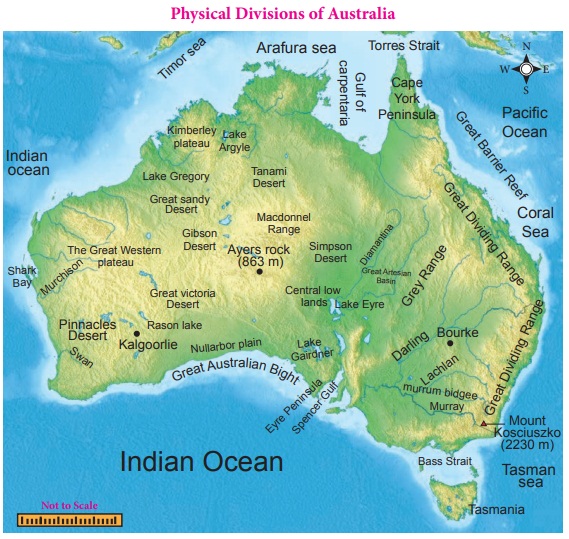
The Great Western Plateau
The Western Plateau is Australia's
largest physical division. It incorporates one third of the continent. Its area
is about 2,700,000 square kilometers. It is an arid land covering large part of
Western Australia, Southern Australia and the Northern Territory.The flat
surface is covered by sandy and rocky features.
Ayers rock or Uluru is the largest
monolith rock in the world. It is found in the central part of this arid
region. It is 863 meters high above the sea level. It is one of the natural
wonders of Australia. The pointed limestone pillars called Pinnacles are common
in this region.
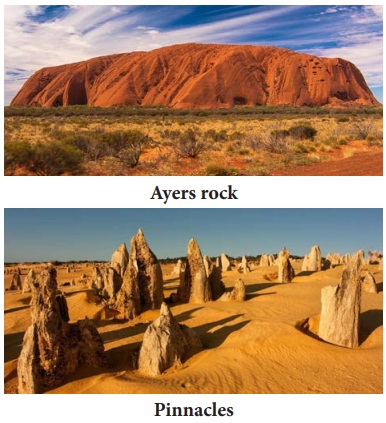
The McDonnell and Musgrave ranges
are located in this plateau the treeless region of Nullarbor Plain is located
in the southern part of this plateau. The Great Victoria Desert is the largest
desert in Australia located in Western Australia and South Australia.
The Central Low lands
The central lowlands extend from the
Gulf of Carpentaria in the north to Indian Ocean in the south. In the centre of
these low lands lies the large inland drainage basin of Australia. Lake Eyre is
the largest salt lake lies in this region. The Murray–Darling River system lies
in the south-eastern part of the central lowlands. Beneath the central
lowlands, huge artesian basins are found.
The Eastern Highlands
The eastern highlands extend for
about 3860 km along the eastern edge of Australia. It stretches from Cape York
in the north to Tasmania in the south. They are also known as the ‘Great Dividing Range’ as it separates
the west and east flowing rivers.
Australian Alps mountain range is
the highest mountain range of Australia. It is covered with ice. The highest
peak of this range is Mt. Kosciuszko (2230m) and is located in the New South
Wales.
Australia has two important natural
features that have enriched the country. They are
1.
The Artesian Basin
2. The Great Barrier Reef.
The Great Artesian Basin
The Artesian Basins are regions on
the earth’s surface where water gushes out like a fountain. The great artesian
basin in Australia is the largest and deepest basin in the world. The artesian
basin is located in the west of the Great Dividing Range. It is found in the
arid and semi-arid parts of Queensland, New South Wales, South Australia and
Northern Territory. It extends for 1.7 million square km and it is also a major
source of water in this region.
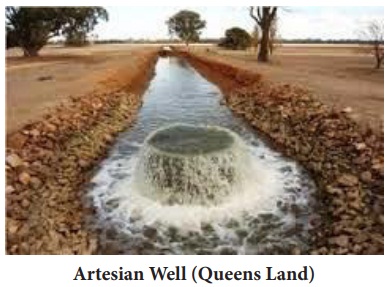
Great Barrier Reef
Great Barrier Reef is located in the
North East of Australia along the East Coast of Queensland in the Pacific
Ocean. It is formed by the tiny coral polyps. It is about 2300 kilometers long.
It is one of the natural wonders of the world.
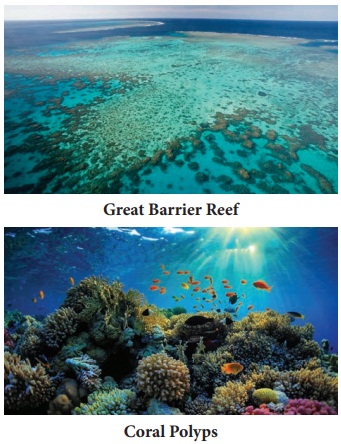
Drainage
Australia receives low average
rainfall. Being a hot dry country, the rate of evaporation is high in this
country. So, there is a very little amount of water left to flow as river to
the seas. The River Murray and its tributary are the main rivers and a major
drainage basin of Australia. This drainage basin is found in the interior part
of the lowlands of Australia. It covers more than one million sq km which is
about 14 per cent of area of Australia.
Bourke is the place in
Australia where the highest temperature is recorded (53°C). It is located in
the central low lands. The lowest temperature of the country is recorded in
Canberra, the capital of Australia (-22°C).
River Murray is the longest river in
Australia. It runs 2508 km from Australian Alps to the Indian Ocean. Darling,
Alexandria, Murrumbidgee, Lachlan and Swan are the other important rivers of
this continent.
Climate
Australia contains the second
largest area of extremely arid land in the world. The Tropic of Capricorn
divides the Australia into two equal parts. The Northern half is in the warm
tropical zone and the southern half is in the cool temperate zone. The north
coastal region experiences monsoon type of climate and there is a heavy
rainfall during summer. The east coastal region receives good rainfall from
south east trade wind. The hot desert climate extends from central lowlands to
western shores. The rainfall in this region is less than 25cm per annual.
Mediterranean type of climate prevails in the southern tip of Australia in the
region around Perth and Adelaide. Tasmania gets rain throughout the year from
westerly winds.
Flora and Fauna
Australia is a semi-arid region.
Hence, the vegetative cover is not mainly composed of trees but of scattered
shrubs and herbs. Bird’s eye view of Australia would reveal a very simple
vegetation pattern. The plants and trees in Australia are adapted to dry
conditions and can survive for long period without water. They are called Xerophytes. Eucalyptus is the most
common tree in the west as it can withstand long period of drought. Forests and
woodlands together represent about 16 per cent of the area of Australian
continent. Eucalyptus, Acacia and Melaleuca (swamp forests) are the major trees
of Australia.
About 80 percent of animals in this
country are not found in the other parts of the world. Australia has almost 400
mammal species and about 140 species of marsupials. These are the animals that
carry their young ones in their pouches. Kangaroo is the national animal of
Australia. Koala, platypus Wallaby and Dingo are the other important animals of
Australia. The bird species like the laughing kookaburra, emu, and rainbow
lorikeet are the major birds of Australia.

The people who work in
the sheep stations in Australia are known as Jackaroos. Aborigines are the
indigenous people of the Australia.
Economic Activities
Agriculture, forestry, fishing,
mining, manufacturing, trade and services are the major economic activities of
Australia. Wheat is the chief grain crop of Australia. Rice, sugarcane
Mediterranean fruit like grapes, oranges and apricots are produced around
Perth, Adelaide and Melbourne. Tasmania is known as the Apple Island. Rice, tobacco and cotton are grown in the northern parts of Tasmania. Sheep rearing is carried
out along with cultivation in the regions of warm climate. Oats, maize and
barley are also cultivated to some extent. Australia is well known for
Vineyards and Orchards. Cattle rearing is common in the tropical savannas and
sheep farming in the temperate grassland. Merino
sheep are rearing in southern Australia, Tasmania, Victoria and New South
Wales. Dairy cattle are reared in farms close to the cities of east and south
coast. Among dairy cows Illawarra, Jersey and Ayrshire are the most popular in
Australia.
Fishing is also a major economic
activity of Australia. Marine fishing is popular in the entire coastal regions
of the country. Inland fishing is very limited. Forest resources are also very
limited in the country.
The sheep industry is well
developed in Australia. The wool is described as the ‘Cash Crop’ of Australia.
Mineral Resources
Minerals are the largest export item
of Australia. It contributes about 10 percent of country’s GDP. Australia is
the world’s leading producer of bauxite, limonite, rutile and zircon, the
second largest producer of gold, lead, lithium, manganese ore and zinc, the
third largest producer of iron ore and uranium and the fourth largest producer
of black coal .The coal belts of the country stretches from New Castle to Sydney
on the south eastern coast. Iron ores are found mainly in southern and Western
Australia.
Bauxite is mined around the gulf of
Carpentaria, perth and Tasmania. Petroleum and natural gas is obtained from
Bass Strait and west of Brisbane. Uranium is mined in northern territory at Ram
jungle and Queensland. Gold is mined in the western desert at Kalgoorlie and
Koolgarlie. Lead, Zinc, Silver, Manganese, Tungsten, Nickel and copper are also
mined in parts of Australia.
Industries
Food and beverage manufacturing
industry is the primary industry in Australia. Finance, ship building,
information and technology, mining, insurance, aviation and telecommunication
industries are the other important industries.
ACTIVITY : There are eight deserts in Australia. List them
out with the help of Atlas.
Answer:
i. Central Desert
ii. Gibson Desert
iii. Great sandy Desert
iv. Great Victoria Desert
v. Little Sandy Desert
vi. Simpon Desert
vii. Strzelecki Desert
viii. Tanami Desert
The temperate grass
land of Australia is known as 'Downs'.
Transport
Many form of transports are
available in Australia. This country is highly dependent on road transport.
There are more than 30 airports with paved runways. Passenger rail transport
includes widespread commuter networks in the major cities with limited
intercity and interstate networks.
Population
As of 2019 the population of
Australia is about 25.2 million. It constitutes only 0.33% of the total world’s
population. The population density of Australia is 3 persons per sq km. Urban population
of the country is about 85.7 percent. Southeastern part of Australia is the
densely populated region.
Related Topics